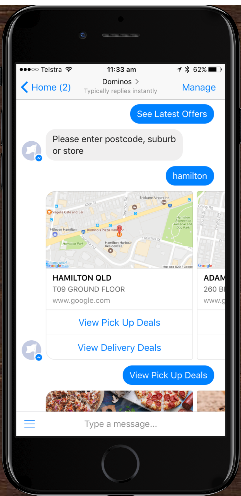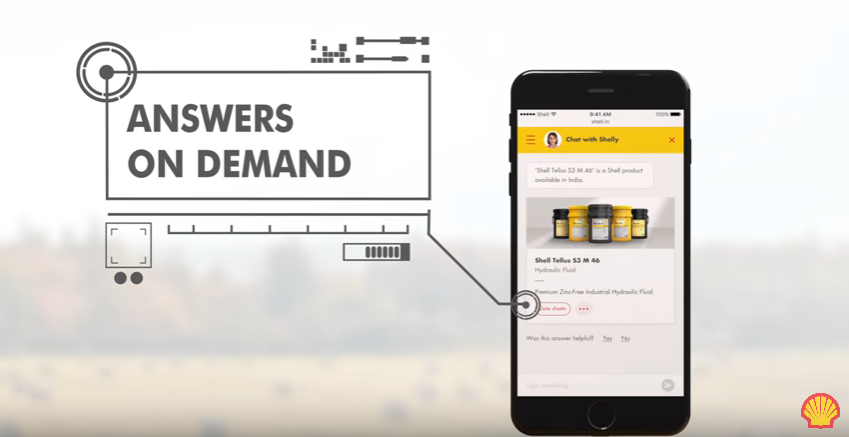How Chatbots are Transforming Businesses and the Society
How Chatbots are Transforming Businesses and the Society
Chatbots automate customer interaction. Whether it’s talking to customer service, asking for information, filing a complaint, starting a therapeutic conversation, recommending products, ordering pizza, finding a job, or even making purchasing and banking transactions, chatbots can make it all happen quickly and cost efficiently.
In other words, if an interaction falls in either seeking information or making something happen, there’s a good chance chatbots can do it. With more than 300,000 chatbots present in Facebook Messenger alone, many businesses and organizations have already realized the potential of automated customer interaction.


Chatbots and customer service
Most of the 1.3 billion monthly users of Facebook Messenger are still unaware (or it didn’t register in their minds) of chatbots. But slowly and gradually (and perhaps a giant leap eventually), more and more users might take advantage of automated and real-time interaction with a
The first and most common use of such bot interaction is in talking to customer service (filing an issue, getting more information about a product or service). After all, no one wants to waste time just to get a quick information or let the company know something is wrong with their product or service. We hate the queue and we want information or action right here right now.
Top Articles on How Businesses are using Bots:
For a new technology to be useful, it has to make something faster, easier, or more efficient. But in this case, the relatively new technology (the use of chatbots and machine learning) is making things real time. In addition, it’s about reducing or eliminating human interaction in the entire process.
For example, if you initiate a contact with Mastercard Facebook Page (attempt to send them a message), a prompt will instantly appear in the chat box: How much do your products and services cost?; Tell me more about your business; Can someone assist me?
Choose one and you’ll receive an automated reply. From there you can go further depending on your intent. The automated reply will be customized depending on which button you tap. If your request is much more complex or requires special assistance, your query might be forwarded to real humans.
What was the purpose of the bot then? It reduced human interaction because the initial steps were already taken cared of by the bot. If necessary, a real human can interfere if your request or query is outside the bot’s capability. But what if we can automate the entire interaction from initial inquiry down to the purchase?
Order pizza, plan a trip, book reservations
People can now order a pizza through the chatbot of Domino’s Pizza (without leaving Messenger). There’s no need for calling and discussing which one to order. Instead, just open the Messenger (whether you’re just hungry or an in-app Domino’s Pizza ad appeared while you’re on Messenger) and you can order quickly.


This is a fast way of buying something without going through the lengthy process of human interaction. However, notice that it’s already similar to how we do online purchases through a website. The difference is that you can somehow talk (like having a standby assistant 24/7) and you don’t have to exit Messenger to make something happen.
It’s similar to bypassing some steps and processes in addition to human interaction. Before, you might need to open a web browser and click a website before you can order. But now, you can skip all that and instead order directly through a messaging app. The process can be compared with using Alexa or Google Assistant when you need information. Instead of opening Firefox or Google Chrome and then typing something, you can just say “Ok Google (or Alexa), how many meters are there in 5 feet?” Then, you’ll get a voice reply of something like “5 feet equal 1.524 meters.”
In essence, there’s nothing fundamentally new about the use of the chatbots mentioned. The purpose is still the same (get information, make something happen). The process is just different or there are steps that have been skipped. This way, the transaction will be much faster (or happening at real time).
What makes chatbots interesting (or alarming isn’t it?) is that it can automate several processes, replace humans, and save on staffing costs. Aside from making an inquiry or ordering something (where the process is straightforward and a lot of user input is still required), chatbots can become widely used in heavily personalized interactions and transactions such as making hotel reservations and booking a flight. For example, you can make Hello Hipmunk in Messenger as your personal travel assistant. Through Messenger, first you get three options (Travel Advice, Search Flights, and Search Hotels) and then you can send questions such as “When’s the best time to fly from SFO to London?” and “I’m looking for a beach vacation from New York on 7/10 to 7/17.” Then it can reply with some good recommendations it pulled from various airline, hotel, and travel sites. In addition, calendar items and booking emails are also being accessed to build personalized itineraries.
It’s like having a virtual assistant 24/7 similar to J.A.R.V.I.S. used by Tony Stark. Instead of asking a human to do it all for you (e.g. talking to a travel agent), chatbots can reduce or even totally eliminate human interaction. What’s interesting about this is the operations can scale up (thousands of customers being serviced simultaneously) without hiring dozens more of people and expanding the offices (plus buying more office equipment and furniture). This can result to huge cost savings that can be reinvested back to the business or invested to new business opportunities.
Chatbots in big and traditional industries
When it comes to new opportunities and technologies, huge and traditional industries such as banking and chemicals are also quick to act. Although these industries are less or rarely mentioned in the news regarding the use of chatbots and artificial intelligence, the chemicals and banking industries are actually investing huge sums in emerging technologies and applying these in many of their operations.
For example, there’s the Shell LubeChat that acts like a 24/7 “advisor” to engineers. With this online chat tool, anytime engineers can ask questions such as “What lube meets this specification…?”, “What’s the Shell alternative to…?”, and “What’s the physical characteristics for…?”
Other questions related to the use of oils and lubricants can also be answered by the Shell LubeChat. This can help industrial personnel get answers on demand (whenever, wherever) and empower them to make better informed decisions. This 24/7 online chat robot can also help industrial personnel find the appropriate products, access technical and safety sheets, get a recommended Shell alternative, and access relevant case studies on how existing customers improved their operations.
This is just a start. What if that same capability is also applied in other chemical industries aside from oils and lubricants? Imagine the impact to many industries such as companies producing coatings, adhesives, sealants, catalysts, pesticides, fertilizers, animal health products, vitamins, food additives, polymers, and water management chemicals. Industrial personnel will have access to technical information and expertise whenever and wherever they are. These industries could then move forward much faster because of that high level of empowerment.


Aside from chemical industries, more and more banks and financial institutions are using chatbots to provide prompt information to clients. For example, through the Kasisto’s Kai Banking Platform (a conversational AI platform), Mastercard customers can ask about their balances (“What are my balances?”) and reply something like “You have $5,733.63 and owe $2,412.61. Shall I break that down?” Customers can also ask about their spending summary right through the platform (“Summarize my spending.”)
This looks the same as logging in and viewing your balances, spending, and other financial information. The difference is that it’s more interactive and dynamic. Again, it’s like having an assistant with you to whom you can ask for information. This might even help encourage financial literacy and awareness because the information is right under the customers’ fingertips anytime (plus the interaction is conversational). But this virtual assistant actually does more than provide you with information. You can actually make financial transactions (“Pay Jing 5 for coffee”) and the bot will handle it for you. Instead of navigating an app or online account, you can just say it straight and the transaction will be done.
Chatbots that can facilitate commercial transactions can be really useful in getting things done much faster. People will also just need to use a few apps (Messenger) to get a lot of those things done. The messaging app becomes a one-stop shop platform where people can achieve a mobile lifestyle.
WeChat and the mobile lifestyle
There are now chatbots in Facebook Messenger that facilitate commercial transactions. It’s like inside the app there are a lot of other apps that allow people to do a wide variety of things.
That concept is not new at all. That’s because WeChat has been doing it in China for years now. Aside from sending text, voice, and photos to friends and family, people living in China can also use WeChat to buy movie tickets, send money to friends, get banking statements, book a doctor appointment, pay the water bill, order food delivery, hail a taxi, and a lot more. As a result, WeChat has enabled a mobile lifestyle wherein this app is now addressing every aspect of its users’ lives (both social and non-social).
This could be the end game or ultimate destination of chatbot, Facebook Messenger, and other messaging apps. Both social and non-social interactions (even finding a job through Newton, your AI friend that gets you hired) will be taken cared of. And yes, this goes beyond commercial interactions and transactions.
May A.I. Help You?
That’s the title of a recent article published in The New York Times website (May A.I. Help You?). It’s an interesting read about the impact of conversational AI on everyday life.
For example, Woebot (yes, a chatbot) is designed to help people cope with feelings of anxiety and depression. This “chatbot therapist” uses cognitive behavioral therapy to help people make their mental health more manageable (thinking through situations step by step, learning about ourselves with intelligent mood tracking, and getting evidence-based lessons, exercises, and stories from a clinical team).
Note that this goes beyond commercial interactions. It’s about saving people’s lives and helping them feel better. This is also about giving 24/7 assistance to people suffering from feelings of anxiety and depression. In addition, there are times and there are people in many places where access to mental healthcare is difficult. But with Woebot that is fully operational 24/7, people can get some help wherever and whenever.
Again, this replaces human interaction. Instead of scheduling an appointment with a doctor or clinician and waiting for help to come, people can take charge and seek help immediately. This might not be a full replacement to visiting the clinic but it’s still a great supplement to improving mental health.
Aside from coping with feelings of anxiety and depression, chatbots can also help fill our social void. If we want someone to talk to or listen to us, chatbots can be our best friend. In fact, there are now chatbots that can act as your virtual girlfriend or boyfriend.
This goes beyond replacing doctors and customer service staff with a chatbot. It’s actually about replacing a human being we can talk to. There are no transactions or any kind of immediate goal. It’s just about talking with someone and perhaps making it a worthwhile experience (just like talking with a friend).
For example, Mitsuku (to date, it’s the world’s best conversational chatbot) responds like a real human being. I went to the Mitsuku page and asked her if she has a boyfriend, her response:


It’s natural and the humor got me. It might even be better or more entertaining than the average human being when it comes to chatting and sustaining a conversation. And after some time, it gets scary because of how good it is. It talks with you like a real human and “she” does it with hundreds (or even thousands) of people on the web all at the same time.
Although Mitsuku is considered artificial, its responses might be inspired or derived from normal human conversations. After all, AI is about learning from data and then demonstrating things that resemble human abilities and intelligence (having a conversation, reasoning, problem solving, making things happen). If we have enough quality data from which we can create a system that demonstrates human conversational skills, it makes way for a lot of possibilities.
One such possibility is to create a chatbot that whenever it replies, you feel like it’s someone you know. This has been done already and the following example might make you question some things.
In the article Speak, Memory published in The Verge, a woman rebuilt her best friend (who died in an accident) using artificial intelligence. In other words, the woman built a bot that mimicked a person’s speech patterns (using the thousands of text messages her friend had sent her over the years). As a result, when interacting with the bot, it feels like she’s talking to her best friend.
This opens a lot of possibilities when it comes to the building of chatbots. What if you have a bot that sounds like a Hollywood celebrity, a politician, a dead scientist, or someone you know who’s not talking to you for a reason (e.g. an old friend, your parents). The use of chatbots may result to making things faster and automated. But often, technology affects more than just commercial transactions, it also affects other aspects of our everyday lives including our social interactions.
Going beyond
In the beginning we mentioned something about automating customer interaction. But what about automating human interaction and replacing humans entirely?
It’s discomforting especially when we’re talking about potential huge job losses because of automation. Replacing an entire department with bots might make the company save money and become more agile and competitive. But if this happens in every other company, expect initial job displacement on a large scale. Although many people are optimistic about the future of chatbots and AI (e.g. emerging technologies may result to the creation of new jobs), it’s hard to ignore the initial job losses resulting from the wide implementation of AI.
As mentioned, chatbots and AI can have a huge effect not just in how we do business, but also on how we conduct ourselves daily. Should we call a friend or just a talk to a bot? Should we go out and date or just find a virtual girlfriend? Is it good to talk to a bot that resembles someone’s personality (a politician, a celebrity, or a loved one)? What if a chatbot can replace you?
About the author: Joshua Delos Reyes is a chemist with AI and machine learning background. He lives in Tarlac, Philippines. Contact him about your next AI project. LinkedIn |Thinking Resources Consulting| [email protected]
相關推薦
How Chatbots are Transforming Businesses and the Society
How Chatbots are Transforming Businesses and the SocietyChatbots automate customer interaction. Whether it’s talking to customer service, asking for inform
Are MES systems dead? How IoT and AI are transforming the shop floor
Manufacturing is changing due to advancements in the Internet of Things (IoT) and Artificial Intelligence (AI). With consumer demand for customization dri
Automation and AI in Retail: How are stores coping with the change?
Automation and AI in Retail: How are stores coping with the change?The retail shopping experience is constantly evolving. The stores of the future may look
How to list the open file descriptors (and the files they refer to) in my current bash session
轉載 自https://unix.stackexchange.com/questions/333186/how-to-list-the-open-file-descriptors-and-the-files-they-refer-to-in-my-curren Yes, this will li
You are what you think, what you read, who you with, and how you are taught.
I am a student in Wuhan University, one of the prestigious universities in China. My major is the automation. My profession is chosen b
How One Blockchain Startup is Transforming Travel and Increasing Accessibility in Cities
How One Blockchain Startup is Transforming Travel and Increasing AccessibilityWe all know that social networks and digital content distribution is controll
Top 5 Ways Chatbots are Revolutionizing the Hotel Industry
Top 5 Ways Chatbots are Revolutionizing the Hotel IndustryHotel Guest interacting with Customer Service BotIn the world of the hotel industry, chatbots are
How Artificial Intelligence Is Helping Children And The Elderly
Although most people don't realize it, AI is already helping humanity to meet some growing challenges. It's being used to help us care for the elderly and
Researchers develop 3D printed objects that can track and store how they are used
But these plastic parts don't have electronics, which means they can't monitor how patients are using them. Now engineers at the University of Washington
Neuroscience and Artificial Intelligence; How They are Perpetuating Each Other’s Progress
Neuroscience and Artificial Intelligence; How They are Perpetuating Each Other’s ProgressBefore I even delve into these, if not the most, existential topic
How semiconductor companies are adopting IoT and AI to drive new revenue growth models
The semiconductor industry is one of the fastest growing sectors in technology. Information provided by the Semiconductor Industry Association (SIA) reveal
Best practices, how-tos, use cases, and internals from Cloudera Engineering and the community
One instance of Cloudera Manager (CM) can manage N clusters. In the current Role Based Access Control (RBAC) model, CM users hold privileges and permi
Searching for a diagnosis: how scientists are untangling the mystery of developmental disorders
Helen Firth, a clinical geneticist at Cambridge University Hospitals, has spent her career trying to help those affected by rare diseases.“Once you’ve got
How we screwed things up on Product Hunt and the #1 rule you need to follow to avoid it
How we screwed things up on Product Hunt and the #1 rule you need to follow to avoid itBeing on Product Hunt front page is a huge deal for startups, especi
How My Email Account Got Hacked and the Steps I Took After Finding Out
How My Email Account Got Hacked and the Steps I Took After Finding OutHow I found out how my email account got hacked and what steps I took to prevent futu
Top 3 Reasons Why Chatbots Fail in Finance [And How to Fix Them]
We use cookies to give you the best online experience. By using our website you agree to our use of cookies in accordance with our cookie
The Freedom of WHY and the Limits of HOW
The Freedom of WHY and the Limits of HOWBirds are free, but even for them the sky's the limit (by Maurice Schalker on Unsplash)I’m Florian and I co-founded
【賤賤的夢想】There are only two creatures in the world who can surmount the pyramid —— the eagle and the snail.
賤賤的夢想 There are only two creatures in the world who can surmount the pyramid —— the eagle and the snail....
Soul of the Machine: How Chatbots Work
Since the early industrial age, we’ve been fascinated by self-operating devices. They represent the humanization of technology.Today, it is software that t
LightOJ 1341 Aladdin and the Flying Carpet(唯一分解定理)
void 都是 scanf esp for space tar sqrt lld http://lightoj.com/volume_showproblem.php?problem=1341 題意:給你矩形的面積(矩形的邊長都是正整數),讓你求最小的邊大於等於b的矩形的個
